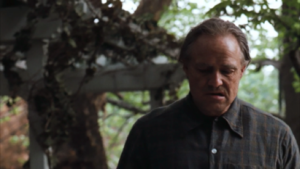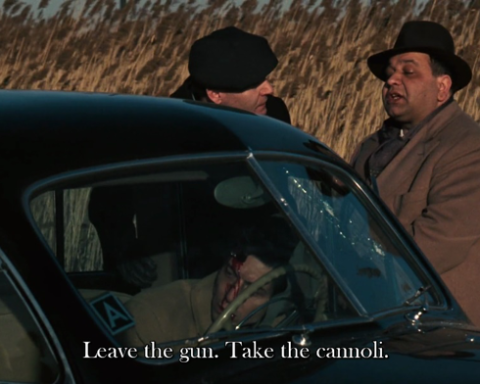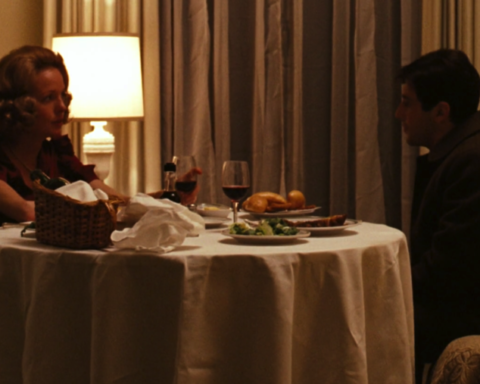
We begin the scene in a noticeably dark garden: Michael Corleone has his back to us on the left, while his father, Vito Corleone, looks away to the right. They are meeting to go over Michael’s possible assassination from a traitor in the business. The scene of their meeting — in a garden —strikes a different note from earlier Godfather scenes, in which business is handled indoors, and in dark and private rooms. Yet it is not so different: the fencing encloses the garden and gives it an exclusive feel, and the lighting is gray rather than sunny and bright, suggesting the death that looms over both Don Vito and Michael (between the previous attempt on Vito’s life and a possible future attempt on Michael’s).
Although the scene is set in a garden, which might evoke the work of women (gardening) or the play of children (a suggestion taken up by the bicycle in the background), we see that the ground is mostly dirt with some big trees near the dark concrete border mentioned earlier. Too, the placement of Don Vito and Michael at the edge of the garden and not in the middle—where there are rows of vegetables being cultivated —reinforces the idea that they are not in the garden to pass the time but to go over a plan to keep Michael safe. Michael is, after all, living his life “on the edge,” and so it is fitting that he confers with his father on the edge of the garden rather than in its more sunny center. The atmosphere may be more informal than usual in the Corleone family business, but there’s no question of its seriousness. In fact, the nature that surrounds Michael and Vito acts as a framework that preserves the transfer of power between father and son as a natural and conventional gesture.

The same frame allows us to take notice of Vito Corleone and how he has been worn down by age. His hair is a dull gray, with white accents; his skin is wrinkled; he wears stubble, as if he has stopped keeping up appearances. Another critical point about the first frame is how Vito Corleone isn’t looking directly at Michael. Instead, his eyes are low and looking elsewhere. In the same manner, we don’t have access to Michael’s face. Our only way to discern how Michael is feeling at this particular moment is through his body. He leans towards his father in a concerned and caring manner.
However, moments later, the camera shifts, and we see Michael’s face and only the back of Vito Corleone’s head. Unlike Vito Corleone, Michael’s hair is black, his face is young-looking, and even his clothes are more polished compared to Vito Corleone’s old style and almost faded shirt. The difference in clothes accentuates how Vito Corleone has retired as the head of the family business and can wear comfortable clothes and be outdoors.
We come back to Don Vito as he tells Michael that he has been drinking more wine. The brief moment presents a shift in mood. Don Vito drinking the wine makes the scene appear more casual. In the background we can hear the birds chirping; the conversation eventually turns to them talking about Michael’s family, with a focus on his son. The mention of Michael’s son and his ability to read the funny papers lightens the mood; for the first and only time in the scene, Vito’s face spreads into a smile and we feel his affection for his family.



The happiness vanishes fairly quickly, and the scene continues to dramatize the disconnect between Michael and Don Vito. Vito and Michael’s lack of eye contact suggests many things at once. First, as part of different generations, they are constantly seeing things from a different perspective. Don Vito is still in the old habit of going over plans, and Michael has to continue reassuring him that he has already taken care of things. Second, there is a guardedness to the warmth between them: constant eye contact might be dangerous — too affectionate, too soft, for this father and son. As Robert Towne, who was brought in to script this scene, has suggested, “they couldn’t just outwardly declare their love for each other.” Lastly, there’s the possibility that Don Vito can’t look at Michael because he can’t literally face the reality that his son has become the new Don Corleone.
This last suggestion is taken up by Vito’s dialogue in the last part of the scene, which brings out both the tenderness and guardedness of their rapport. Vito gets up from his seat and sits closer to Michael, making the space between him and Michael significantly smaller. Even though Don Corleone stands up, he doesn’t have a strong presence nor much authority in the frame because his eyes are still looking down and his walk to the seat is sluggish. The scene exposes his old age even more by closing in on his aged features.
Here the lighting underscores Don Corleone’s smallness. Despite the fact that Don Corleone is closer to the screen because of where he is seated, his appearance is darkened, and Michael’s face is lit up in profile. The lighting naturally forces our eyes to focus on Michael’s face, making us see Don Corleone as a mere shadow, almost insignificant. Under the safety of the shadows, Don Corleone permits himself to utter the words, “But I never wanted this for you.” The confession enables the scene to reach a higher level of intimacy without the need for light or eye contact because the words carry all the weight. This instance of vulnerability communicates how important the family is to Vito, so much so that he taps into the unconventional tenderness of fatherhood. The sense of vulnerability is heightened by the shadow that drapes Vito’s face — a shadow that, given Vito’s age, seems not unrelated to the shadow of death.

An alternative reading of this particular moment might suggest that Michael and his father are two sides of the same coin. The main difference is that Don Corleone has his eyes looking to the left as he reflects on his past, while the frame forces Michael to look to the light, towards the future.
Coppola’s particular framing of the back and forth between father and son leaves us asking why they don’t share the screen with full faces at the same time. Perhaps the camera purposefully only grants one or the other to stress the difference in generations and how that affects the future of the godfather role. After all, this scene was written so that there could be “a visible transfer of power from father to son.” The scene wraps up with Don Corleone kissing Michael on the cheek, giving last-minute warning of the traitor, and then walking off the frame of the lens. Immediately, we see Michael lay down.

The last frame with Michael slumped in a pillowed chair conveys the weight he now bears. In the scene as a whole, Michael has become newly sympathetic — he’s framed as the son who wants to free his elderly father from the burden that is work. At the close of the scene, we see that he has taken on that burden, along with the conviction that he is the new Don Corleone. Having given the viewer that assurance, the scene fades out to the next.








